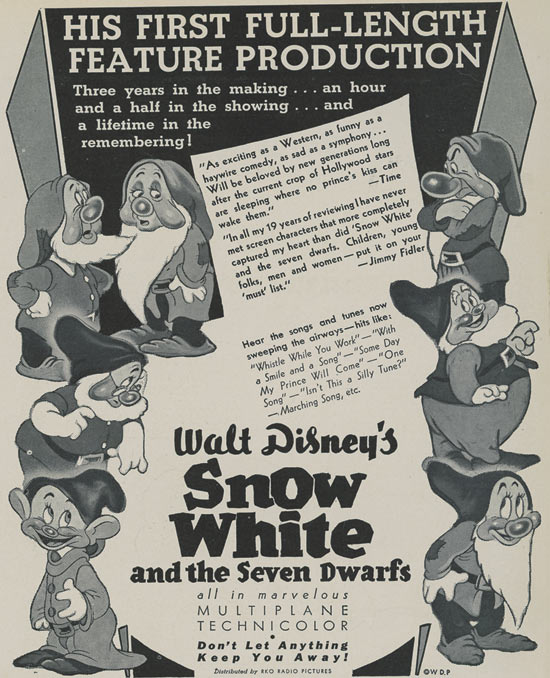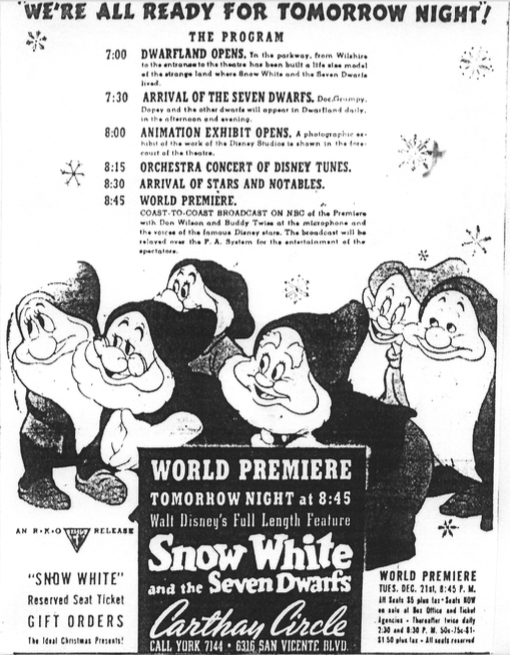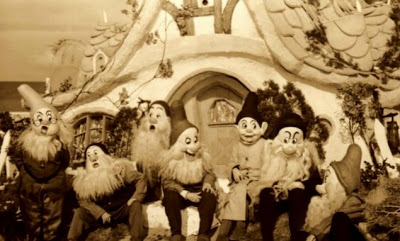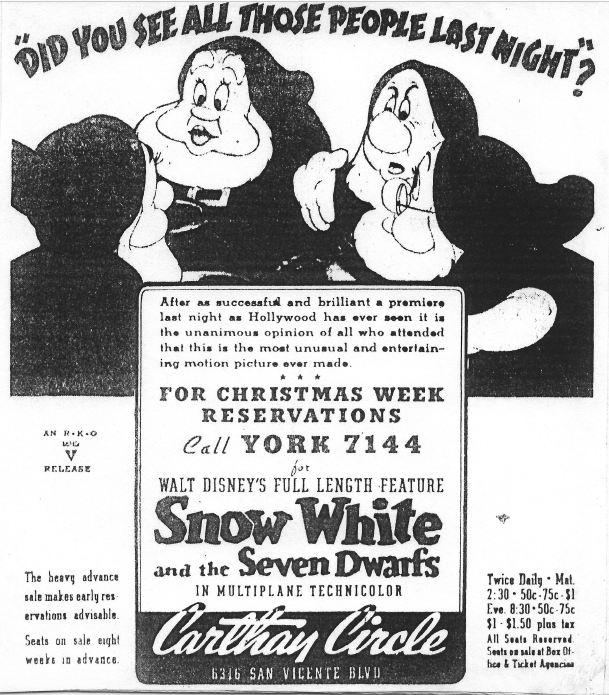Snow White and the Seven Dwarfs, or “Disney’s folly” as critics called it, was the Walt Disney Company’s first animated feature-film, but with a budget of over $1.5 million it was in no way a sure success. Walt, however, was willing to risk his company on a move to feature-length animation, because changing audiences and changing distribution agreements meant that the company’s shorts would no longer support the company’s endeavors. While profit lay in feature films, Disney was unsure if audiences would be interested in a seven-reel cartoon that focused more on personality and character development than slapstick and bright colors.[i]
Prior to Snow White’s opening on December 21, 1937 at the Carthay Circle Theatre, The L.A. Times exclaimed that Disney had created new stars and that the premiere would be unusual. Other articles explained that not even Disney’s staff had seen the full film, so they were paying $5 to buy a ticket to the premiere.[ii] Even the actors who supplied the voices for Snow White and the Prince had not been given tickets, but had to sneak into the theatre.[iii] It was a clever marketing ploy, if not perhaps the actual truth.
In the week prior to the premiere there were numerous articles describing the party that was planned, while detailing the celebrities to be in attendance, the prices people were paying for tickets, and the fact that days before the premiere it was standing room only.[iv] A December 20th article described the event as “every seat has been taken and the list of celebrities who purchased $5 tickets is one of the most formidable ever announced.”[v] That list included Marlene Dietrich, Katherine Hepburn, Shirley Temple, and Cary Grant. Spectators were promised appearances by Mickey and Minnie Mouse, the Seven Dwarfs, and Disney’s recording orchestra playing the movie’s songs.
The most lavish aspect of the film’s premiere, however, occurred outside of the theatre and remained as an attraction to future audiences: Dwarfland. Dwarfland was a life-sized recreation of the dwarfs’ forest built in the parkway from Wilshire Blvd. to the entrance of the Carthay Circle Theatre. Theatre-goers could walk through Dwarfland and encounter all of the dwarfs. In addition, the entrance to the theatre displayed art work that was used in the creation of the film. These exhibits were hailed in advertisements as “educational and fascinating,” while also explaining that they were Disney’s Christmas present to the viewing public.[vi] Advertisements also described how families and parties had made reservations to view the film on Christmas Eve.[vii] In other words, Disney wanted to make sure audiences knew the film would entertain the whole family and should be included in their holiday plans.
In addition to articles in magazines and newspapers, the premiere was broadcast on the NBC Blue network. Hosted by Don Wilson and Buddy Twiss, the show aired for 30 minutes prior to the movie’s 9:15 pm start and featured voices from the Disney film.[viii] Disney also used radio to advertise the movie through commercials and song rotations. By the first week in February, when the film was setting attendance records in Los Angeles and New York, the “Whistle while you work” song became the second most plugged, with “With a smile and a song” and “Someday my prince will come” added to the list.[ix]
Overall, the premiere was a success. Reporters described the overflowing audience as being enraptured by a film that “is a triumph of technical craft, disclosing the finest artistic feeling of its impresario and his assistants.”[x] In addition, the audience was said to be crying by the end and gave the film a standing ovation.[xi] Reviewers, even when pointing out the faults of the film, primarily the lack of reality of the human characters, still described it as being a miraculous victory.[xii]
Disney would use this positive publicity in later advertisements for Snow White. One series of ads showcased the reviews of prominent critics who proclaimed that the movie was not just for children. Quotes from celebrities were also featured. For instance, Charlie Chaplin commented: “in dwarf Dopey he [Disney] has created one of the greatest comedians of all times.”[xiii]
Disney’s careful planning quickly paid off. In the first week of showings at Carthay Circle, Snow White earned $19,000; the second highest gross for a film’s opening week.[xiv] The film would eventually break all records for the theatre and be the most successful holiday release.[xv] In fifteen months of domestic release the film earned more than $6.7 million dollars.[xvi] Not only did Snow White save the Walt Disney Company, but it was also a boon to theaters where previous films were averaging one-third less than revenue. The success helped theaters still struggling from the Great Depression and bolstered their desire to show other Disney animated films. So much for Disney’s folly.
Pamela C. O’Brien is an Associate Professor and the Chair of the Communication Arts Department at Notre Dame of Maryland University. She has been researching and presenting about animation for over 25 years. She is a critical cultural scholar who studies adult-oriented TV animation, Disney feature-length animation (especially how and why Disney altered classic fairy tales), and the history of TV animation. She also researches social media and has co-founded the Social Media Technology Conference and Workshop.
[i] Paul Harrison, “‘Snow White,’ $1,600,000 Disney screen creation, now ready for public”, The Washington Post (January 9, 1938): 1 sec.6.
[ii] Anon, “Disney staff pay to see own product”, The Los Angeles Times (December 18, 1937): 7 part II.
[iii] Adriana Caselotti, “Snow White speaks”, People Weekly, 27 (May 18, 1987): 102-105.
[iv] Edwin Schallert, “Cartoon actors claim spotlight”, The Los Angeles Times (December 12, 1937): 1; Anon, “Disney creates new stars”, The Los Angeles Times (December 17, 1937): 11 part II.
[v] Anon, “Gala premiere”, The Los Angeles Times (December 20, 1937): 9.
[vi] Walt Disney [Advertisement], “Join the Happy crowds!”, The Los Angeles Times (December 26, 1937): 3 part III.
[vii] Walt Disney [Advertisement], “Did you see all those people last night?”, The Lost Angeles Times (December 22, 1937): 11 part II.
[viii] Anon, “‘Snow White’ premiere due tonight”, The Los Angeles Times (December 21, 1937): 10.
[ix] Anon, “Breakdown of network plugs”, Variety (February 2, 1938): 47.
[x] Edwin Schallert, “‘Snow White’ achievement in film art”, The Los Angeles Times (December 22, 1937): 11.
[xi] Roger Coons, “‘Snow White,’ Disney’s first full-length film”, The Washington Post (January 9, 1938): 1 sect. 6.
[xii] Schallert, 11; Douglas Churchill, “Walt Disney sighs for more whirls”, The New York Times (January 9, 1938): 5 sect. 10.
[xiii] Walt Disney [Advertisement], “Snow White and the seven dwarfs”, The Los Angeles Times (January 13, 1938): 10.
[xiv] Anon, “‘Snow White’ L.A. smash at $19,000”, Variety (December 29, 1937): 8.
[xv] Churchill, 5 sect. 10.
[xvi] Anon, “‘Snow White’ sets mark with $6,740,000 gross”, The New York Times (May 2, 1939): 29.





3d animation